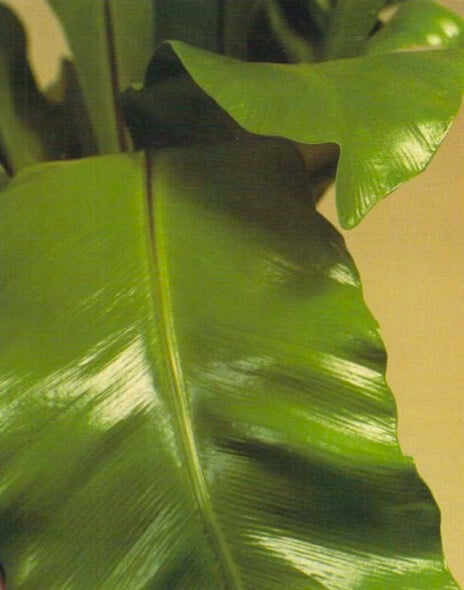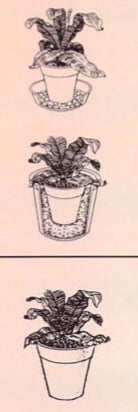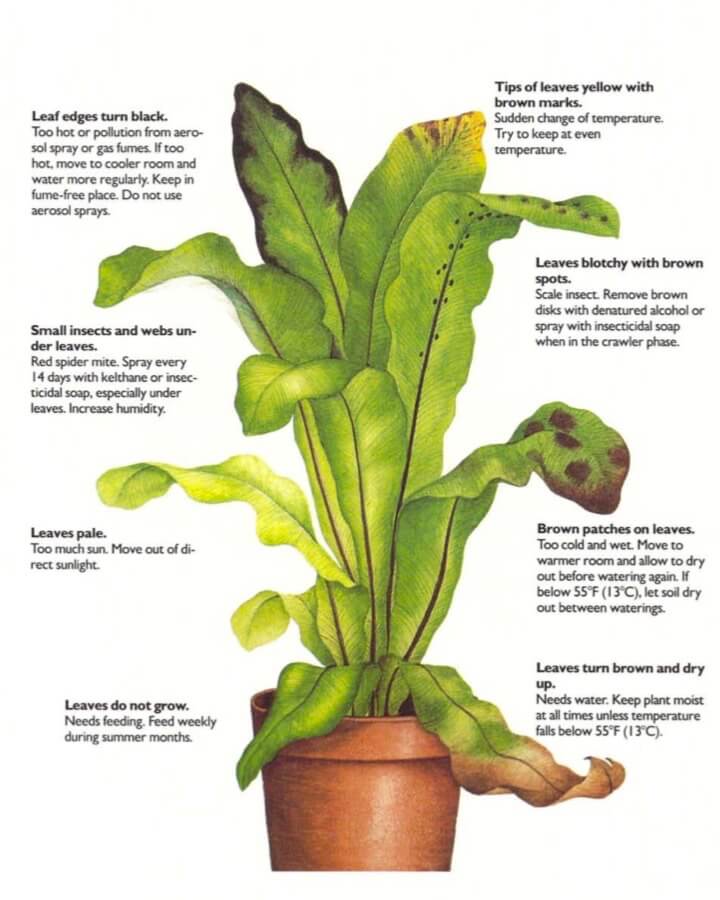[Ebook Việt Hoá] The Instant Guide to Healthy Houseplants (Hướng dẫn tức thời để chăm cây trong nhà khoẻ mạnh), Chi Asplenium (Phyllitis) - Chi Tổ Điểu
[Ebook Việt Hoá] The Instant Guide to Healthy Houseplants: Asplenium nidus (Bird’s nest fern)
- Nguồn: [Ebook Việt Hoá] The Instant Guide to Healthy Houseplants (Hướng dẫn tức thời để chăm cây trong nhà khoẻ mạnh)
- Biên tập: Dũng Cá Xinh
- Biên dịch: Team Codai.net
English
This attractive, popular houseplant is relatively easy to grow, provided that it is not kept in strong light. Its new leaves unfurl delicately into thick, broad adult leaves, which grow from a central point and form a well. In imperfect conditions, older, outside leaves become mottled and must be removed at their base with sharp scissors. In a shaded greenhouse or fernery, adult leaves may grow to 5 feet (1 1/2m). This plant grows on trees in its natural habitat, obtaining nourishment from both rainwater and the decaying plant matter around it.

Light
Place in a semi-shaded location to produce healthy leaves. Strong light keeps new growth pale.
Temperature
Winter minimum, 55°F (13°C); summer range. 70-75° F (21- 24°C)
Water
Water twice a week in summer and once every 10 days in winter to keep moist at all times. If at minimum temperature in winter, plant should just dry out before being watered again.
Humidity
Plant thrives in moist atmosphere. Spray twice weekly in summer. once weekly in winter. Stand on saucer of pebbles almost covered with water to help maintain humidity.
Feeding
Feed weekly in summer with houseplant food diluted with water according to manufacturer’s instructions.
Soil
Use peat-based. not loam-based, blends.
Repotting
Repot into clay pot in spring only when root-ball seems closely packed. A 5-in (13-cm) pot is adequate for a 15-inch- high (38-cm) plant. It has less root than other ferns.
Cleaning
Spray with soft water. and wipe leaves carefully after-wards. Use no leafshine.
Humidity
Provide constant humidity by standing pot on saucer of damp pebbles. Do not allow pot base to stand in water. Or place in larger, outer pot packed with damp peat moss.
Repotting
This plant has a small root system, which will probably not grow through base of pot. Examine roots in spring. If they are all growing close together so that soil is obscured. repot in pot one size larger.

What Goes Wrong

- Leaf edges turn black: Too hot or pollution from aerosol spray or gas fumes. If too hot. move to cooler room and water more regularly. Keep in fumefree place. Do not use aerosol sprays.
- Small insects and webs under leaves: Red spider mite. Spray every
- 14 days with kelthane or insecticidal soap. especially under leaves. Increase humidity.
- Leaves pale: Too much sun. Move out of direct sunlight.
- Leaves do not grow: Needs feeding. Feed weekly during summer months.
- Tips of leaves yellow with brown marks: Sudden change of temperature. Try to keep at even temperature.
- Leaves blotchy with brown spots: Scale insect. Remove brown disks with denatured alcohol or spray with insecticidal soap when in the crawler phase.
- Brown patches on leaves: Too cold and wet. Move to warmer room and allow to dry out before watering again. If below 55°F(13°C), let soil dry out between waterings.
- Leaves turn brown and dry up: Needs water. Keep plant moist at all times unless temperature falls below 55°F(13°C).
Tiếng Việt
Loại cây trồng phổ biến, hấp dẫn này tương đối dễ trồng, miễn là nó không được để ở nơi có ánh sáng mạnh. Những chiếc lá mới của nó dễ dàng bung ra thành những chiếc lá trưởng thành dày và rộng, mọc từ điểm chính giữa và tạo thành một cái giếng. Trong điều kiện không hoàn hảo, các lá già bên ngoài trở nên đốm và phải dùng kéo sắc cắt bỏ từ cuống lá. Trong nhà kính có bóng râm hoặc cây xanh, lá trưởng thành có thể dài tới 5 feet (1 1 / 2m). Loài thực vật này mọc trên cây trong môi trường sống tự nhiên của nó, lấy chất dinh dưỡng từ cả nước mưa và thực vật thối rữa xung quanh nó.

Ánh sáng
Đặt ở nơi có bóng râm để cây ra lá khỏe mạnh. Ánh sáng mạnh làm cho lá mới bị nhợt nhạt.
Nhiệt độ
Tối thiểu mùa đông là 55 ° F (13 ° C); phạm vi mùa hè khoảng 70-75 ° F (21-24 ° C)
Nước
Tưới nước 2 lần / tuần vào mùa hè và 10 ngày / lần vào mùa đông để luôn giữ ẩm cho cây. Nếu ở nhiệt độ tối thiểu vào mùa đông, cây nên để khô ráo trước khi tưới trở lại.
Độ ẩm
Cây phát triển mạnh trong môi trường ẩm ướt. Phun hai lần một tuần vào mùa hè và một lần hàng tuần vào mùa đông. Đặt trên đĩa sỏi gần như phủ đầy nước để giúp duy trì độ ẩm.
Bón phân
Bón phân hàng tuần vào mùa hè bằng phân bón hữu cơ pha loãng theo hướng dẫn của nhà sản xuất.
Đất
Sử dụng hỗn hợp pha trộn từ than bùn không phải đất mùn.
Thay chậu
Chỉ thay chậu đất sét vào mùa xuân khi rễ cây có vẻ mọc chật chội. Chậu 5 inch (13 cm) là đủ cho cây cao 15 inch (38 cm). Nó có ít rễ hơn các loại dương xỉ khác.
Làm sạch
Xịt nước mềm và lau lá cẩn thận sau đó. Không sử dụng xịt bóng lá.
Độ ẩm
Cung cấp độ ẩm ổn định bằng cách đặt chậu trên đĩa sỏi ẩm. Không để đế chậu đọng trong nước. Hoặc đặt trong chậu lớn hơn, bên ngoài có phủ rêu than bùn ẩm.
Thay chậu
Loại cây này có bộ rễ nhỏ, có thể sẽ không phát triển qua đáy chậu. Kiểm tra rễ vào mùa xuân. Nếu chúng đều mọc sát nhau để đất bị che khuất thì thay chậu vào chậu lớn hơn một chút.

Những vấn đề có thể xảy ra

- Rìa lá chuyển sang màu đen: Quá nóng hoặc ô nhiễm do phun sol khí aerosol hoặc khói khí. Nếu quá nóng chuyển sang phòng mát hơn và tưới nước thường xuyên hơn. Giữ ở nơi không có khói. Không sử dụng thuốc xịt aerosol.
- Côn trùng nhỏ và mạng nhện dưới lá: Nhện đỏ. Xịt thuốc kelthane hoặc xà phòng diệt côn trùng 14 ngày một lần, đặc biệt là dưới lá. Tăng độ ẩm.
- Lá nhợt nhạt: Nắng quá. Tránh ánh nắng trực tiếp.
- Lá không mọc: Cần bón phân. Bón phân hàng tuần trong những tháng mùa hè.
- Đầu lá vàng với vết nâu: Thay đổi nhiệt độ đột ngột. Cố gắng giữ ở nhiệt độ đồng đều.
- Lá lấm tấm đốm nâu: Sâu bọ. Loại bỏ bằng cồn biến tính hoặc phun xà phòng diệt côn trùng khi ở giai đoạn bò sát.
- Các mảng màu nâu trên lá: Quá lạnh và ẩm ướt. Di chuyển đến phòng ấm hơn và để khô trước khi tưới lại. Nếu dưới 55 ° F (13 ° C), hãy để đất khô giữa các lần tưới.
- Lá chuyển sang màu nâu và khô héo: Cần tưới nước. Luôn giữ ẩm cho cây trừ khi nhiệt độ xuống dưới 55 ° F (13 ° C).
![[Ebook Việt Hoá] The Instant Guide to Healthy Houseplants: Asplenium nidus (Bird’s nest fern) [Ebook Việt Hoá] The Instant Guide to Healthy Houseplants: Asplenium nidus (Bird’s nest fern)](https://vn1.vdrive.vn/codai.net/2020/02/ebook-huong-dan-tuc-thoi-cham-cay-trong-nha-khoe-manh-89-asplenium-nidus.jpg)


